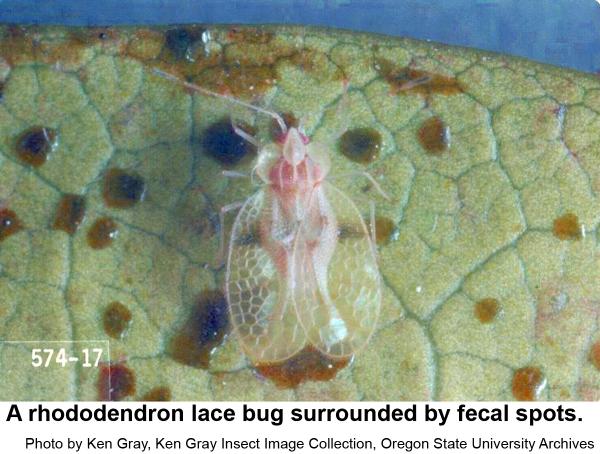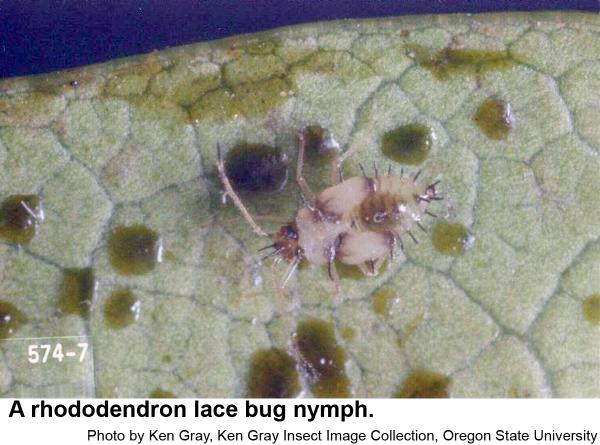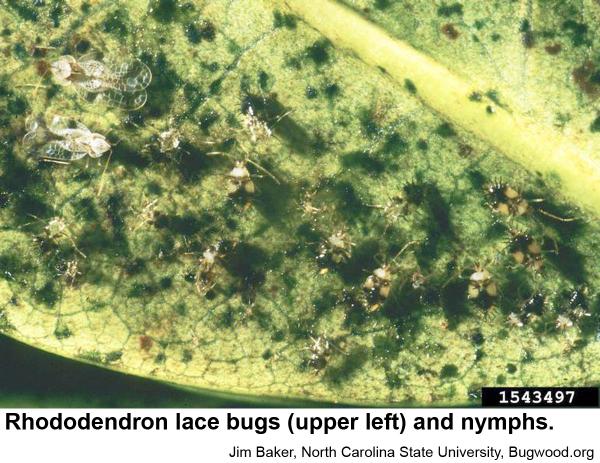Description and Biology
The rhododendron lace bug, Stephanitis rhododendri, is about 1/8 inch long with wide, net-like or lace-like wings. These lace bugs are whitish or yellowish with yellowish legs and antennae. Nymphs are spiny, and dark, and develop through four growth stages. The largest nymphs are only about 60% as long as adults. Nymphs feed on lower leaf surfaces, clustered among their dark fecal spots and cast nymphal skins. Females insert yellowish-white eggs into the midrib of the lower leaf surface so that only the top of the egg would be visible if each egg were not covered with a varnish-like material by the female. This insect overwinters in the egg stage. Eggs hatch from late April through May. Nymphs feed on the lower leaf surface. A complete life cycle, from egg to adult, may be completed in thirty days under optimal conditions. One to three generations are produced each year depending upon altitude, climate, and the length of the growing season. As rhododenron lace bugs feed, they inject saliva that kills and predigests cell contents. They then suck out the predigested liquid. Feeding results in pale stippling visible on the upper surface. Such damage might be confused with that of mite injury. Lace bug injury, when observed closely, reveals chlorotic spots that are larger than those caused by mites as well as cast skins and larger fecal spots on the lower leaf surfaces
Host Plants
Rhodoendron lace bug feeds on over 120 types of rhododendrons as well as mountain laurel and fetter-bush. Leaves that are damaged in the spring remain stippled look for the whole growing season. The undersides of infested leaves often have nymphs, adults, cast skins, and black fecal spots or at least cast skins and fecal spots.
Residential Recommendations
Lace bug eggs are plagued by tiny parasitic wasps. However, these natural control agents often fail to prevent noticeable damage. Lace bugs can be relatively difficult to control. Perhaps this is because the eggs are inserted into the leaf tissue and covered with a drop of varnish-like excrement and are thereby protected from insecticides, especially during the winter. It's best to treat in early spring, which helps keep later populations low. Because the spring generations seem to do the most damage, it is a good idea to monitor the new growth for the first signs of damage. Orthene is relatively effective for lace bug control, but it is somewhat harsh on predators and parasites. Insecticidal soaps and horticultural oils are toxic to nymphs and adults, but they do not kill eggs nor do they provide any residual control (and thus are safer for parasites and predators). Safari and imidacloprid are systemic insecticides that can be applied to the soil surface to kill the lace bugs above. Acelepryn and Flagship soak into the leaf, but do not move systemically in the plant.
Other Resources
- Lace Bugs, Frank, S. D. and S. Bambara. 2009 (revised). Entomology Insect Notes. NC State Extension Publications.
- Lace Bugs on Broad-Leaved Evergreen Ornamental Plants. Hoover, G. A., Sr. 2003. PennState College of Agr. Sci.
- Rhododendron Lace-Bug. Antonelli A. and Davidson, R. Jr. 2002. Cooperative Extension Washington State University, Purallup PLS-120.
- The Lace Bugs (Hemiptera: Tingidae) of North Carolina and Their Hosts. Horn, K. F., C. G. Wright, and M. H. Farrier. 1979. NC Agr. Exp. Sta. Tech. Bul. 257. 22 pp.
- The Tingoidea of New England and Their Biology. Bailey, N. S. 1951. Entomologia Americana 31: 1-140.
- Insect and Related Pests of Shrubs. Baker, J. R. ed. 1980. NC Agr. Extension Service pub. AG-189. 199 pp
- Extension Plant Pathology Publications and Factsheets
- Horticultural Science Publications
- North Carolina Agricultural Chemicals Manual
For assistance with a specific problem, contact your local N.C. Cooperative Extension center.
This Factsheet has not been peer reviewed.
Publication date: March 28, 2019
Revised: Jan. 10, 2024
Recommendations for the use of agricultural chemicals are included in this publication as a convenience to the reader. The use of brand names and any mention or listing of commercial products or services in this publication does not imply endorsement by NC State University or N.C. A&T State University nor discrimination against similar products or services not mentioned. Individuals who use agricultural chemicals are responsible for ensuring that the intended use complies with current regulations and conforms to the product label. Be sure to obtain current information about usage regulations and examine a current product label before applying any chemical. For assistance, contact your local N.C. Cooperative Extension county center.
N.C. Cooperative Extension prohibits discrimination and harassment regardless of age, color, disability, family and marital status, gender identity, national origin, political beliefs, race, religion, sex (including pregnancy), sexual orientation and veteran status.




